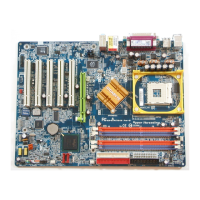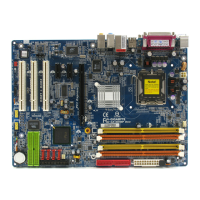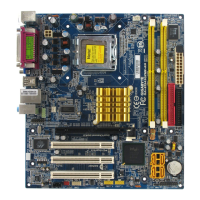
Do you have a question about the Gigabyte GA-8IPE1000 and is the answer not in the manual?
| Form Factor | ATX |
|---|---|
| Socket Type | Socket 478 |
| Chipset | Intel 865PE |
| Supported CPU | Intel Pentium 4 / Celeron |
| Front Side Bus | 800/533/400 MHz |
| Memory Type | DDR SDRAM |
| Memory Slots | 4 |
| Maximum Memory | 4 GB |
| Expansion Slots | 1 x AGP 8x, 5 x PCI |
| Storage Interface | IDE, SATA |
| IDE | 2 x ATA100 |
| SATA | 2 x SATA 1.5Gb/s |
| USB Ports | 8 x USB 2.0 (4 rear, 4 via headers) |
| Audio | Realtek ALC655 6-channel |
| LAN | Realtek 8101L 10/100 Ethernet |
Details systems that do not support AGP 2X cards, preventing boot issues.
Illustrates specific AGP card compatibility with different modes and motherboard series.
Confirms compliance of Gigabyte's AG32S(G) card with AGP 4X(1.5V) specification.
Author is not responsible for errors, omissions, or commitments to update.
Warns against removing labels, as it may void the warranty.
Notes that specifications may be outdated due to rapid technological changes.
Declares conformity of Mother Board GA-8IPE1000 series with EMC Directive.
Declares conformity of Motherboard Model GA-8IPE1000 Pro/GA-8IPE1000 with FCC Part 15 rules.
Lists the key specifications and features of the GA-8IPE1000 Series Motherboard.
Visual diagram showing the placement of components on the motherboard.
Illustrates the functional blocks and data flow of the motherboard components.
Detailed guide for installing the Central Processing Unit (CPU) onto the motherboard socket.
Instructions for installing DDR memory modules into the DIMM sockets.
Procedure for installing expansion cards into PCI or AGP slots.
Identifies and explains the connectors on the motherboard's I/O back panel.
Detailed listing and explanation of various motherboard connectors and jumper settings.
Lists keyboard shortcuts for navigating and controlling the BIOS setup utility.
Overview of the primary sections and functions available in the BIOS setup.
Configuration of date, time, IDE devices, and floppy drive settings.
Management of boot priority, CPU features, and system passwords.
Control over onboard hardware like IDE, SATA, USB, LAN, and audio.
Settings for ACPI states, power button behavior, and wake-up events.
IRQ assignments for PCI slots and Plug and Play configurations.
Displays system voltages, temperatures, fan speeds, and warning thresholds.
Option to choose the display language for the BIOS setup utility.
Adjustments for CPU clock speed, memory frequency, and voltage settings.
Resets BIOS to fail-safe or optimized factory default values.
Establishes supervisor or user passwords for BIOS access and security.
Options to save changes to CMOS and exit, or exit without saving.
Guide to the Windows-based utility for updating BIOS live from the internet.
Introduction to the Windows-based overclocking and hardware monitoring utility.
Instructions for customizing the boot-up logo using the Face-Wizard utility.
Explains methods for updating the BIOS, including Dual BIOS and Q-Flash.
Guides on setting up 2-, 4-, and 6-channel analog audio output modes.
Explains automatic audio jack detection and signal switching features.
Guide for backing up and restoring the operating system partition using Xpress Recovery.
Instructions for installing chipset and other essential hardware drivers from the CD.
Lists and briefly describes value-added software included with the motherboard.
Frequently asked questions and a flowchart for resolving boot-up issues.
Step-by-step guide to diagnose and resolve boot-up problems.












